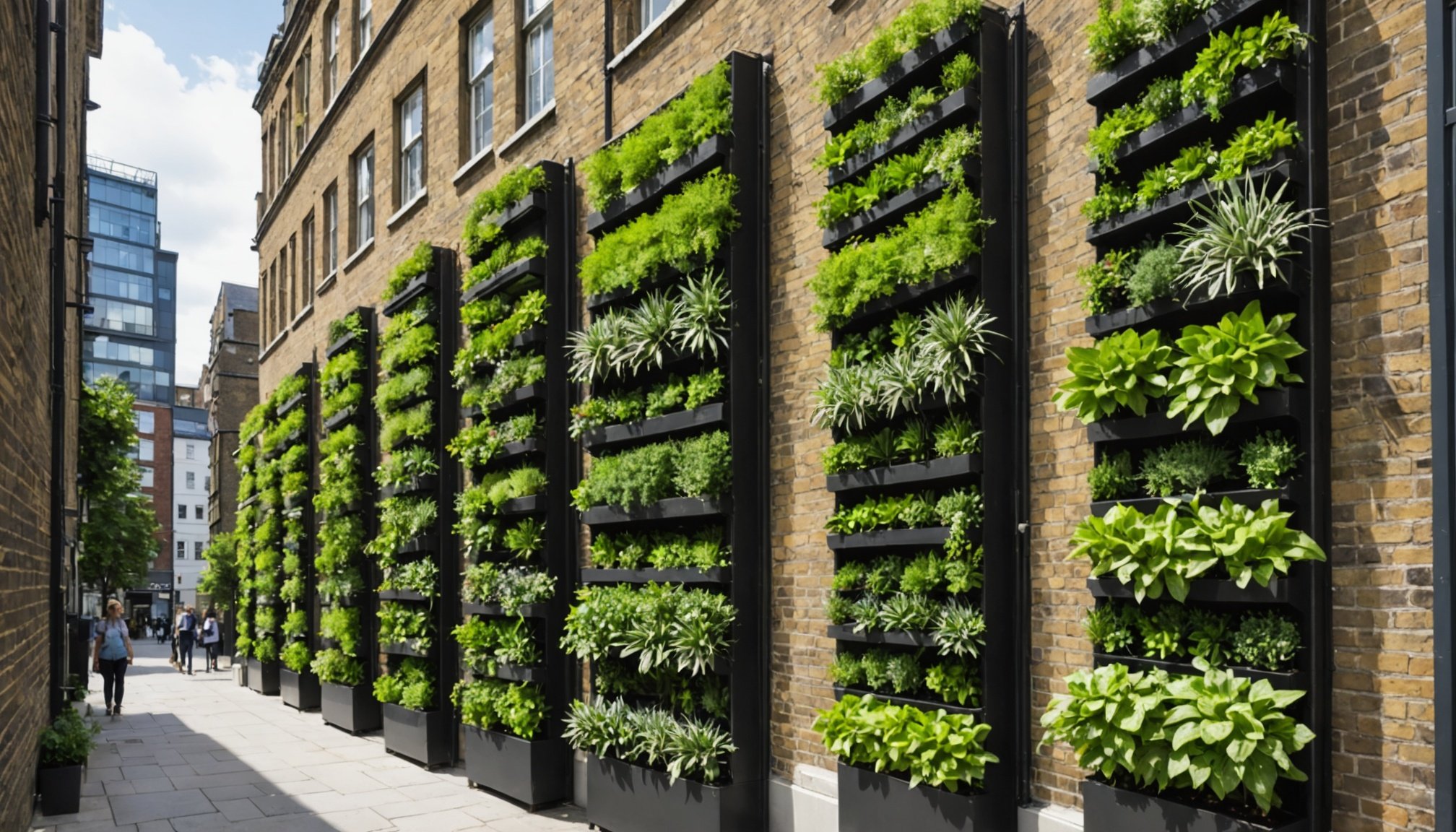Urban living often constrains green space, leaving city dwellers yearning for nature. Vertical wall planters offer a promising solution, transforming limited areas into lush, vibrant gardens. These innovative installations not only enhance aesthetics but also improve air quality and biodiversity. As cities evolve, embracing vertical gardening could redefine urban landscapes. Discover how vertical wall planters can help reconnect residents with nature and enhance their surroundings in the UK’s bustling cities.
Overview of Vertical Wall Planters
Vertical wall planters have become a cornerstone of modern urban gardening, offering a unique solution for those looking to incorporate green spaces into limited areas. These planters are designed to allow plants to grow vertically, making them ideal for urban environments where horizontal space is often scarce.
This might interest you : Ultimate Guide to the Best Mulching Techniques for Weed Control in UK Flower Beds
The primary purpose of vertical wall planters is to maximise the use of available space, transforming bare walls into lush, green landscapes. This method of gardening is particularly popular in cities, where residents often lack traditional garden spaces. By using vertical wall planters, urban dwellers can enjoy the benefits of gardening without the need for a large plot of land.
In recent years, the trend of urban gardening has surged, with vertical wall planters at the forefront. They are not only practical but also add aesthetic value to any environment, turning plain walls into vibrant green spaces. As cities continue to grow, the demand for such innovative solutions is expected to increase.
This might interest you : Transform Your Compact UK Courtyard: Creative Ways to Add a Vegetable Garden
The benefits of vertical wall planters extend beyond aesthetics. They help improve air quality, provide insulation, and support biodiversity. For those with limited spaces, these planters offer a practical way to bring nature into their homes, promoting a healthier and more sustainable lifestyle.
Types of Vertical Wall Planters
Exploring the types of vertical planters available can greatly enhance your urban gardening experience. These planters are crafted from various materials, each offering distinct benefits.
Common Materials
- Wood: Offers a natural aesthetic and is suitable for a wide range of plants. However, it may require treatment to withstand outdoor conditions.
- Metal: Known for its durability and modern look. It's ideal for plants that need sturdy support, but can heat up in direct sunlight.
- Plastic: Lightweight and versatile, making it easy to install and maintain. It’s resistant to weather and often more affordable.
Design Options
Vertical wall planters come in diverse designs to suit different needs:
- Modular Planters: These allow for customisation and expansion, perfect for those looking to tailor their garden.
- Pocket Planters: Feature individual pockets for each plant, offering easy access and maintenance.
- Living Walls: Create a lush, continuous green space, ideal for larger installations.
Suitability for Various Plant Types
Choosing the right planter depends on the plant species. Herbs and small flowers thrive in pocket planters, while living walls are better suited for dense foliage and trailing plants. Consider the plant's needs for sunlight, water, and space when selecting your planter.
Benefits of Vertical Wall Planters for Urban Dwellers
In urban settings, vertical gardening offers a remarkable solution for optimising space, particularly in small homes or apartments. By utilising vertical wall planters, residents can transform unused vertical areas into vibrant gardens, maximising limited space efficiently. This approach not only caters to the spatial constraints of urban living but also introduces a touch of nature into the home environment.
Beyond space optimisation, vertical wall planters significantly enhance urban aesthetics. They provide a unique visual appeal, turning bland walls into striking green displays. This aesthetic transformation can also lead to an increase in property value, as potential buyers and renters often appreciate the blend of nature and design in urban spaces.
Moreover, vertical wall planters contribute positively to the environment by improving air quality. Plants naturally filter air, absorbing pollutants and producing oxygen, which is crucial in densely populated areas. Additionally, these planters support urban biodiversity by creating habitats for various species, such as insects and birds, fostering a miniature ecosystem within the city.
In conclusion, the adoption of vertical wall planters not only addresses the challenges of limited space but also enhances urban living by boosting aesthetics, air quality, and biodiversity.
Installation Tips for Vertical Wall Planters
Installing a vertical wall planter can be a rewarding DIY gardening project. Following a detailed installation guide ensures your plants thrive in their new vertical home.
Step-by-Step Installation Process
- Choose the Location: Select a wall that receives adequate sunlight and is accessible for maintenance.
- Prepare the Wall: Clean the surface and ensure it can support the weight of the planter and plants.
- Mark and Drill: Use a level to mark where the brackets or hooks will go. Drill holes and insert anchors if necessary.
- Attach Mounting Hardware: Secure brackets or hooks to the wall, ensuring they're level and sturdy.
- Hang the Planter: Carefully hang the planter, checking it's secure and level.
- Add Soil and Plants: Fill the planter with soil suitable for your chosen plants, then plant them, ensuring proper spacing.
Essential Tools and Materials Needed
- Drill and drill bits
- Level
- Mounting brackets or hooks
- Anchors (if needed)
- Appropriate soil and plants
Common Mistakes to Avoid
- Overloading the wall with too much weight.
- Ignoring sunlight and water needs of plants.
- Skipping the use of a level, leading to uneven installation.
Case Studies: Successful Vertical Gardening in the UK
Vertical gardening is making waves across the UK, with notable projects in major cities like London and Manchester leading the charge. These urban case studies highlight the transformative power of vertical gardening initiatives in densely populated areas.
In London, the Edible Bus Stop project has turned neglected spaces into vibrant community gardens. This initiative not only beautifies the area but also fosters community spirit and provides fresh produce for locals. The project's success has inspired similar efforts across the city, demonstrating the potential of vertical gardening to enhance urban environments.
Manchester is home to the Hulme Community Garden Centre, which integrates vertical gardening techniques to maximise space and engage the community. This centre serves as a hub for education and sustainability, offering workshops and resources to encourage urban gardening practices.
Testimonials from urban gardeners in these cities reveal the profound impact of such initiatives. Many express a sense of pride and connection to their neighbourhoods, noting that vertical gardening has improved their quality of life by providing green spaces and fostering community interaction.
These UK gardening initiatives exemplify the benefits of vertical gardening, showcasing its ability to transform urban landscapes while promoting sustainability and community engagement.
Environmental Impact of Vertical Wall Planters
Vertical wall planters offer significant environmental benefits, transforming urban spaces into sustainable ecosystems. One of their key contributions is reducing urban heat islands. By covering walls with greenery, these planters help lower surface temperatures, mitigating the heat retention typical in city environments. This cooling effect can lead to reduced energy consumption in buildings, as less air conditioning is required.
In terms of urban ecology, vertical wall planters promote biodiversity. They create habitats for various species, including insects and birds, fostering a thriving urban ecosystem. This biodiversity is crucial for maintaining ecological balance and can improve the resilience of urban areas to environmental changes.
Water management is another area where vertical wall planters excel. They help reduce runoff by absorbing rainwater, which can alleviate pressure on urban drainage systems. This absorption not only prevents flooding but also filters pollutants from the water, contributing to cleaner waterways.
By integrating vertical wall planters, urban areas can enhance their sustainability, creating healthier and more resilient environments. These planters are not just decorative; they are vital components of modern urban planning, offering practical solutions to environmental challenges.
Challenges and Solutions in Urban Gardening
Urban gardening presents unique challenges, particularly in densely populated areas. Space constraints are a primary concern, as many urban dwellers lack traditional garden plots. Vertical gardening offers a solution by utilising vertical spaces, such as walls and balconies, to cultivate plants. This method maximises available space, allowing residents to enjoy gardening without needing expansive areas.
Light availability is another common issue. Tall buildings can obstruct sunlight, crucial for plant growth. To address this, urban gardeners can employ reflective surfaces or strategically place planters in sunlit areas to enhance light exposure. Additionally, selecting shade-tolerant plants can help overcome limited sunlight.
Creative gardening solutions are essential for thriving urban gardens. Self-watering systems and hydroponic setups are innovative options that conserve water and reduce maintenance. These systems are particularly beneficial for busy urbanites who may not have time for daily watering.
Support for urban gardening initiatives is growing, with community programs and online resources offering guidance and assistance. Local workshops and gardening clubs provide valuable knowledge and foster community engagement. By leveraging these resources, urban gardeners can successfully navigate challenges and create flourishing green spaces in their environments.
Expert Opinions and User Testimonials
Vertical gardening is gaining traction, supported by insights from gardening experts who highlight its practicality in urban settings. Horticulturists often emphasise the space-saving benefits of vertical wall planters, noting their ability to transform limited areas into thriving green spaces. They recommend selecting the right plants based on light availability and maintenance requirements, ensuring a successful gardening experience.
User experiences further illustrate the impact of vertical gardening. Many urban dwellers share stories of how vertical wall planters have revitalised their living spaces, bringing nature closer to home. Testimonials frequently mention the joy of cultivating herbs and flowers in small apartments, with users appreciating the enhanced aesthetics and improved air quality.
Community feedback also plays a crucial role in popularising vertical gardening. Urban gardening groups often exchange tips and recommendations, fostering a supportive environment for both beginners and seasoned gardeners. For those new to urban gardening, experts suggest starting with easy-to-grow plants like herbs or succulents, which require minimal care and thrive in various conditions. Engaging with local gardening communities can provide valuable insights and encouragement, making the transition to vertical gardening smoother and more enjoyable.











